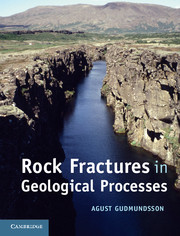Book contents
- Frontmatter
- Contents
- Preface
- Acknowledgements
- 1 Introduction
- 2 Stress
- 3 Displacement and strain
- 4 Relation between stress and strain
- 5 Loading of brittle rocks to failure
- 6 Stress concentration
- 7 Theories of brittle failure of rocks
- 8 Extension fractures and shear fractures
- 9 Displacements and driving stresses of fractures
- 10 Toughness and fracture mechanics
- 11 Field analysis of extension fractures
- 12 Field analysis of faults
- 13 Evolution of extension fractures
- 14 Evolution of faults
- 15 Fluid transport in rocks – the basics
- 16 Fluid transport in faults
- 17 Fluid transport in hydrofractures
- Appendix A Units, dimensions, and prefixes
- Appendix B The Greek alphabet
- Appendix C Some mathematical and physical constants
- Appendix D Elastic constants
- Appendix E Properties of some crustal materials
- Index
- References
6 - Stress concentration
Published online by Cambridge University Press: 05 June 2012
- Frontmatter
- Contents
- Preface
- Acknowledgements
- 1 Introduction
- 2 Stress
- 3 Displacement and strain
- 4 Relation between stress and strain
- 5 Loading of brittle rocks to failure
- 6 Stress concentration
- 7 Theories of brittle failure of rocks
- 8 Extension fractures and shear fractures
- 9 Displacements and driving stresses of fractures
- 10 Toughness and fracture mechanics
- 11 Field analysis of extension fractures
- 12 Field analysis of faults
- 13 Evolution of extension fractures
- 14 Evolution of faults
- 15 Fluid transport in rocks – the basics
- 16 Fluid transport in faults
- 17 Fluid transport in hydrofractures
- Appendix A Units, dimensions, and prefixes
- Appendix B The Greek alphabet
- Appendix C Some mathematical and physical constants
- Appendix D Elastic constants
- Appendix E Properties of some crustal materials
- Index
- References
Summary
Aims
All brittle deformation is related to stress concentration. The deformation, such as the formation of fractures, occurs because the local stresses in certain parts of the crust or rock bodies are raised above the average (nominal) stress in the surrounding parts. Understanding stress raisers and concentrations is of fundamental importance for assessing likely sites for rock-fracture initiation and propagation; in fact, the Griffith theory of fracture (Chapter 7) is partly based on the idea of stress concentrations around small elliptical flaws in brittle materials. The main aims of this chapter are to:
Define the concepts of a stress concentration and a stress raiser.
Provide the basic equations for calculating stress concentrations around elliptical and circular holes and cavities.
Explain stress concentrations in terms of the atomic structure of solids.
Provide an analogy between stress concentrations and fluid flow around obstacles.
Use the equations for stresses around elliptical cavities to explain stress concentrations around fluid-filled reservoirs and magma chambers.
Use the equations for stresses around circular holes to explain stress measurements using hydraulic fractures injected from drill holes.
Basic definitions
Stress concentration occurs when a part of a loaded material has properties that differ from those of the surrounding parts. The easiest way to visualise stress concentration is to consider stresses in a body with a hole or a notch. A hole is a two-dimensional cavity.
- Type
- Chapter
- Information
- Rock Fractures in Geological Processes , pp. 153 - 189Publisher: Cambridge University PressPrint publication year: 2011
References
- 1
- Cited by



